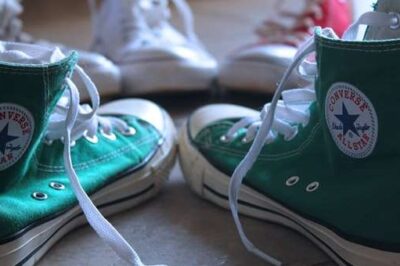One question constantly perplexes me: Why do my shoelaces always come untied? What constantly causes my shoelaces to unravel?
The picture illustrates my frustration. While it might be more reasonable for jogging shoes to eventually come untied because of the ongoing activity, what’s the excuse for common house shoes? What could I possibly be doing to cause those laces to unravel? Am I strolling too briskly through my bedroom?
The “loose laces” conundrum is a global malady. Entrepreneurs continue looking for the shoelace replacement or accessory that will render the lace obsolete (and their bank account full). The trend reminds me of one of my favorite childhood gifts: Velcro shoes. Just grip and rip to tighten or loosen—no laces necessary.
A quick Google search reveals pages of loose lace chat room discussions such as “Adults who can’t tie their shoes, why?” or “The real reason your kid can’t tie yet” dotting the internet. You can watch TED talks devoted to the topic. The world yearns for an effective solution to loose laces!
Thank goodness, scientists took a break from saving the world from disease and famine to focus on shoelaces. Mechanical engineers and scientists at the University of California spent over two years observing one of their lucky colleagues running on the treadmill or casually walking around the workplace. This resulted in an actual study titled “The roles of impact and inertia in the failure of a shoelace knot.”
So why do shoelaces come untied?
The act of planting one’s foot carries amazing levels of force, for starters. In fact, the study determined that the laces experience G-force pressure exceeding the force of a roller coaster. Such force from jogging, we might surmise, that laces unravel under pressure!
Yet pressure is only part of the equation. The article title includes the word “inertia” along with impact. What is inertia? A simple definition is “the tendency of a body to resist a change in motion or rest.” Therefore, an inert object like shoelaces could lie dormant or be in motion.
Nevertheless, the critical difference is the object is resisting change in motion. It could be a dormant object resisting any movement creating force, or it could be a moving object going in a straight line fighting a left turn. My preteen bike-riding self experienced inertia more than once. My 10 speeds barreled down a hill until I suddenly decided the best remedy was to apply the brakes. The bike would stop, but my body kept hurdling painfully forward. Inertia also causes cars moving too fast on a windy road to miss a curve, which explains why you should heed those yellow signs with arrows while enjoying country scenery.
But enough about those transportation modes. We need to get back to my running style. Bottom line, external force eventually unties my laces because they resist the change caused by my running or walking. That and my wimpy knots. Frankly, the double knot always works for me. Sorry mechanical engineers!
A brief summary of the causes for unraveling laces syndrome according to intrepid scientists:
— The laces experience extreme force from an external source (my running) which is applying pressure for the laces to move in whatever direction my awkward strides create.
— The laces resist the pressure to move from the external force. Specifically, the laces fight the pressure to change direction.
Now this does not explain my house shoes. Running shoes, yes. So there is probably an internal force, which is I do a poor job tying my shoes.
Two things cause “The Great Unraveling:”
— The pressure I place on the shoes and laces.
— How the laces respond to the pressure.
Of course, the shoes/laces have no skin in this game. I do. So the response is mine.
Possible solution?
— Double knots.
Again, this is my default position, and frankly, it never fails. However, there is another solution:
— Do a better job tying shoes.
Scientific research unveiled the optimal shoe tying method that leverages the position of the lace at the top of the foot to maximize movement adaptability. Yes, I just wrote that sentence about tying shoelaces. It sounds like a NASA launch sequence. I’m still liking the simplicity of the double knot.
— Seek an alternative.
I did opt for the Velcro option, which lost 80% of the reading audience. And companies are fast-tracking research and development departments to concoct the magical lace elixir. Again, the double knot remains my first option because it must be so much cheaper than digital age alternatives.
This illustration begs another question. Why do I spend so much time fretting over my shoelaces? How many people take time out of their day researching solutions to this perpetual conundrum? Granted, constantly tying shoes is annoying and time consuming. Bending over or kneeling is a pain. Perhaps the causes for unraveling laces are also the reasons other aspects of my life are constantly unraveling.
For example, consider the Christian walk. The G-forces of life exerting full power and my response is to call upon the full reservoir of resistance. This is how things go astray. How should we respond? Subscribe to the Wonkyfied podcast on the Charisma Podcast Network to learn how to respond when life comes unraveled. {eoa}
Dr. Rob Sullivan is an emerging thought leader in politics and policy, urban studies and the Christian walk. He currently serves as dean of the College of Humanities and Social Sciences at Dallas Baptist University. You can follow his podcast on CPN at charismapodcastnetwork.com/show/wonkyfied or learn more at drrobsullivan.com.







Leave a Comment
You must be logged in to post a comment.